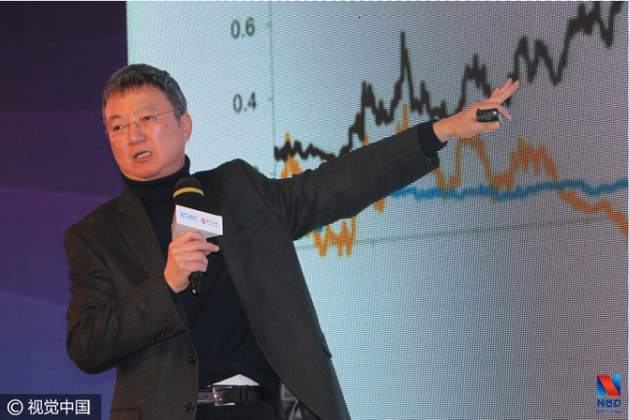
CHENGDU, March 1 (NBD) -- Zhu Min, Chinese economist and former Deputy Managing Director of the International Monetary Fund, shares his observations concerning the world economy development in next decade.
Basic pattern of world economy: running at a low level
The world economy is running at a low level. Despite the sharp rebound in 2010, the global economic growth has been declining slowly. In 2016, the global economic growth rate stood at 3.1%. The U.S. policy may drive the economy slightly up, yet the economy is going downward on the whole.
Currently, inflation rate around the globe is relatively low and PPI is plunging. Most countries' PPI is lower than the general inflation target, meaning that the world falls into deflation. Meanwhile, loose monetary policy pushes the world's real interest rates down. However, this is not a crisis but a balanced state, which we can label as low growth, low inflation, low interest rate, low investment, low oil price, low imports and low FDI.
Why is this happening? The financial crisis in 2008 hit the world worse than expected. For the 8 years after the crisis, global GDP lowered by 12%, which is the major cause for nowadays economic downturn.
According to analysis, the world's potential economic growth rate is determined by the potential growth rate of investment and labor force and labor productivity.
In this sense, the global financial crisis in 2008 pulled down the world's economic development to a low level statically and slowed down the growth rate dynamically, which constitutes a huge structural change.
The world's economy is undergoing structural changes
Firstly, the world's demographic structure is going through profound changes in terms of growing population size and worsening population aging.
Secondly, global economy continues to shift to light industry. Take U.S. for example, when the financial crisis broke out in 2008, American people claimed that the service industry in the country take an overly high proportion while the manufacturing industry is a small part. Former U.S. president Obama put forward to bring the manufacturing industry back to the U.S.. Eight years later, the service industry came down slightly from 78.4%~78.5% to 78%. It is the same case with European countries and emerging economies. Increasingly important light assets make investors less willing to hold heavy assets.
With world's economy leaning towards the light industry, people's demand on commodities is changing as well. The demand elasticity of income on imported goods declines. People's demand for import commodities is not as great as that during early globalization. They tend to buy more domestic service products. The preference towards service products will pose great influence on manufacturing industry, assets preference, trade structure and capital flow in years to come.
Moreover, global investment drops sharply, witnessing 25% decrease in 8 years since the financial crisis in 2008 when compared with that in 2007.
The above characteristics combined present the changes facing global economic structure. Additionally, the world is transforming from the 3rd Industrial Revolution to the 4th Industrial Revolution, and the labor productivity is experiencing structural decline.
In the next decade, to find the new growth for labor productivity is the priority. Because without labor productivity growth, we can't create wealth in order to meet people's needs, let alone to improve income distribution.
The population structure, economic structure, people's preference, labor productivity and investment changes will fundamentally affect the world's economy in the next decade.
The inflection point in global economic policy and politics
Inflection points in global economy will also affect the economic and financial structure.
Firstly, inflection points in economic policies under U.S. president Trump's administration. In conclusion, those policies include: tight monetary policy, raising interest rate to push dollar up; loose monetary policy, investing in infrastructure to create demand; supply-side reform, reducing tax and increasing labor productivity; to expand report through trade war. Although those policies haven't been implemented, yet Trump's policy alters market expectation, becoming a significant inflection point in world's economy and finance.
Secondly, inflection points in interest rate. The major central banks' monetary policies diverge, U.S. raising interest rates, yet Japan and the Europe adopting zero rate or negative interest rate. This intensifies the exchange fluctuations on the monetary market.
Thirdly, inflection points in fiscal policy. The rising inflation rate in the U.S. indicate that the fiscal policy is about to change, which is another huge inflection point. In the future, fiscal policy will replace monetary policy as the dominance in economy. Being subject to political influence, the fiscal policy has greater uncertainties compared with the monetary policy.
Fourthly, inflection points in the rise of populism and political risks.
In conclusion, in the next decade, the world's economy will go through fundamental and structural changes, such as population and economic structure, demand preference and labor productivity, as well as a series of inflection points including monetary policy, fiscal policy and politics. Risks in politics, interest rates and exchange rate will be the major risks facing the world's economy. After prosperous growth and downturn after crisis, the global economy will be restructured, and financial market fluctuations will be increased.
Email: gaohan@nbd.com.cn


 川公网安备 51019002001991号
川公网安备 51019002001991号





